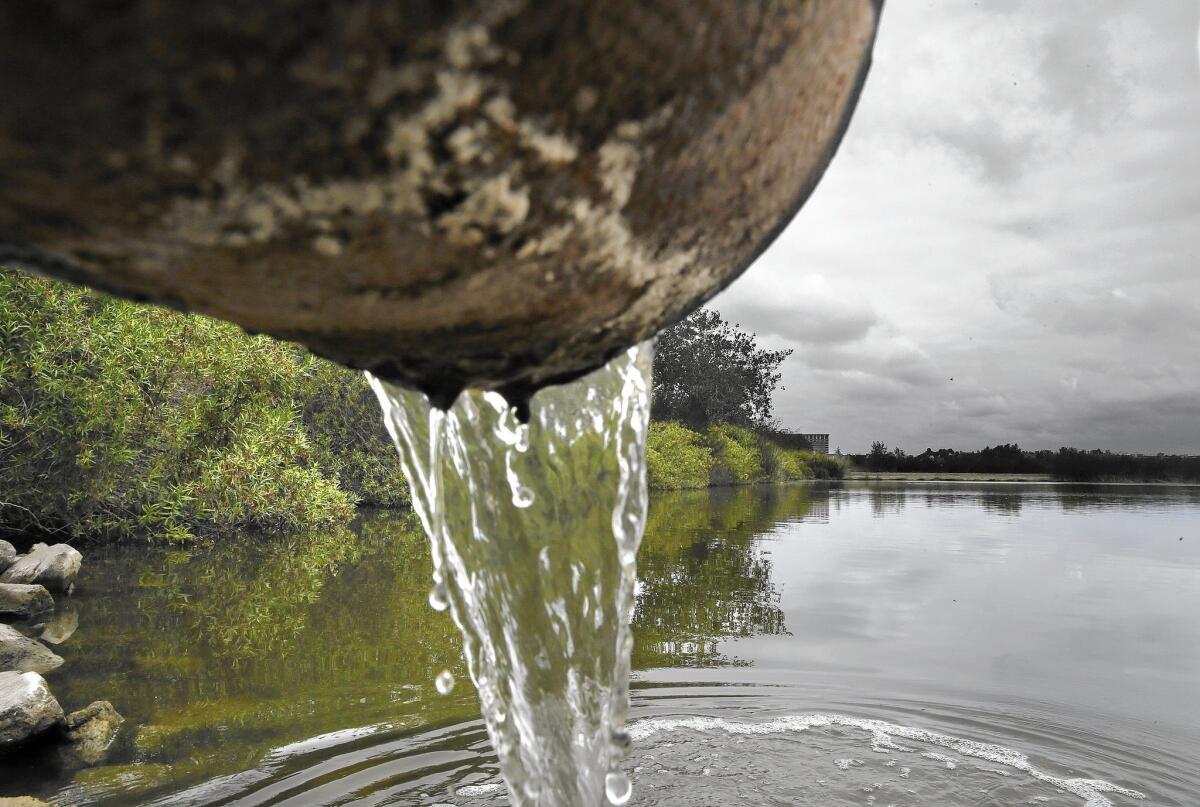California water districts scramble to deal with ruling on rate tiers

During the last major drought in the early 1990s, Irvine pioneered a different approach for calculating water bills for customers.
The city’s water agency allocated each customer a certain amount of water and then charged higher rates to those who exceeded it. The structure has been a wild success: Outdoor water use has dropped almost 50% over the last two decades and residents are using about 25% less water.
But conservation alone is no longer a justification for higher fees, and that has Irvine Ranch and other water districts across California scrambling.
An appeals court last month struck down a tiered rate system in one city that charged more for water than the cost of providing it — a decision that has broad implications across the state. Now, agencies must prove that the high water rates for heavy users are not meant as punishment but actually reflect the cost of delivering the extra water.
An examination of how California water customers are billed shows a wide variety in the way tiered rates are applied, with the biggest users often paying many times more than water savers. Moreover, some districts pass on the costs of certain programs only to heavy users, adding still more to their bills.
Rates in Irvine vary dramatically based on how much water customers use: $0.88 for every 748 gallons (or “unit”) of water in the lowest tier and up to $12.60 in the highest. To justify the most expensive rates, Irvine tacks on the costs of its various conservation efforts to the bills of its heavy water users. Big water users pay for more expensive imported water while light users pay for less expensive groundwater.
Irvine officials insist their methodology passes legal muster because they tie their charges back to specific costs. But some water-rate experts and attorneys say such widely varying rates are going to come under greater scrutiny.
The vast majority of urban water agencies in California use some form of tiered rates, which are seen as a key conservation tool as communities work to comply with Gov. Jerry Brown’s order to slash water use by 25% over the next year.
Long-time rate consultant Sanjay Gaur said aggressively increasing rates — especially those that charge more than $10 per unit — could raise red flags. He estimated that at least a third of the state’s water suppliers would need to “do a better job explaining their tiered rates and the rationality behind them.”
The California 4th District Court of Appeal case involved tiered water rates in San Juan Capistrano. Water officials there charged heavy water users more than $9 for a unit of water, and the court ruled the city failed to base its fees on the actual cost of providing water to customers, as required under Proposition 218.
Since the lawsuit was filed, San Juan Capistrano significantly changed its rate structure.
Under the old system, the lowest tier was $2.47 per unit and the highest was $9.05. The new system increases rates charged to low users to $3.41 and cuts the rates for heavy users to $5.15.
It remains unclear, however, how the new rates will affect conservation now that water is significantly cheaper for heavy users.
Gaur’s consulting firm helped the city craft the new structure and said a main goal was to comply with the court order.
The new rates, he said, “shows the clear nexus between operating costs and price, which is a legal requirement under the recent court decision.”
Other water districts across the state now must also ensure their rates reflect the cost of providing their water.
Such a study is underway in Marin County, where customers’ water prices vary radically. The Marin Municipal Water District uses four tiers, and each is a multiplier of the lowest rate. Those who use the least water pay only $3.74, while those who use the most are charged up to $22.45.
“Our understanding is that our current rate structure meets costs of service, and we’re conducting a review to ensure that any future rate structures also meet that and whatever the new criteria is,” said Libby Pischel, a district spokeswoman.
The San Juan Capistrano case was brought by homeowners who complained that the city’s rates were arbitrary and unconstitutional.
Mike Hensley, an attorney for the residents, said, “huge price differences” between tiers should be viewed with suspicion.
“If you’re going to try to promote conservation, you have to show why,” he said. “You can’t just put a bunch of people in a tier and assume they’re abusers. You can’t just take your budget and reverse engineer.”
The Los Angeles Department of Water and Power now uses a complex two-tiered rate structure that varies depending on time of year and neighborhood, among other factors. Officials are considering expanding to four tiers and making heavy water use more costly.
In Irvine, officials manage to charge big water users more because of how they assign costs.
Only heavy users are charged for the agency’s conservation programming as well as its water treatment system.
IRWD’s treatment system collects and cleans urban runoff caused by excessive water use. The system and the district’s conservation programs are necessary because of customers who use excessive amounts of water, said Irvine Ranch spokeswoman Beth Beeman. Based on that logic, the district believes it can assign the costs of those programs to people who use the most, she said.
“What we’ve always done is recognize that our low volume customers put less demand on our system than the people who are wasting,” said Fiona Sanchez, Irvine Ranch’s director of water resources and former chairwoman of the California Urban Water Conservation Council. “Anytime we get a court ruling it provides additional clarity.”
Just across the freeway from Irvine, another water district has no need to worry about the court ruling.
The Mesa Water District, which serves Costa Mesa and other areas nearby, has used uniform rates for decades.
Last summer, residents served by the district used about 100 gallons of water per person per day, according to state data — slightly more than Irvine Ranch and less than San Juan Capistrano. The district wrote an amicus brief in support of the San Juan Capistrano residents to explain why the tiered rate structure in question was “not cost based and … how it would look if it were.”
Mesa is part of a minority of water districts in California that charges its customers the same amount — in this case, $3.40 a unit — no matter how much water a customer uses.
“We believe our rate structure is simple, understandable and fair and the citizens support it because of that,” said Mesa Water General Manager Paul E. Shoenberger. “It gives customers control over their water bill. If they feel their bill is too high they have the ability to lessen their use on a unit-by-unit basis.”
Twitter: @ByMattStevens
More to Read
Sign up for Essential California
The most important California stories and recommendations in your inbox every morning.
You may occasionally receive promotional content from the Los Angeles Times.











